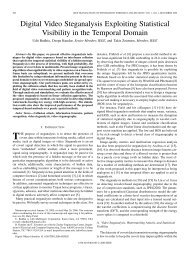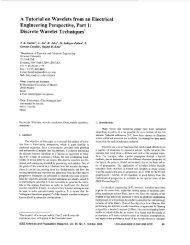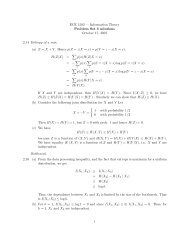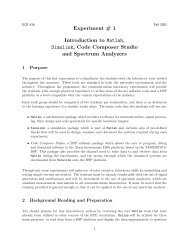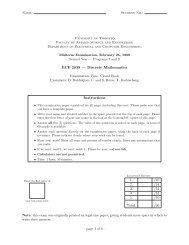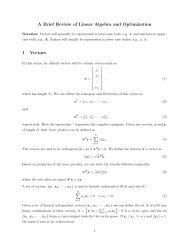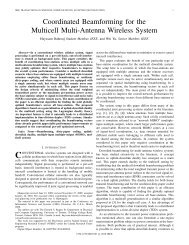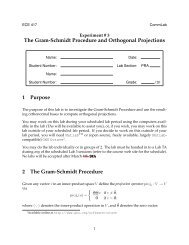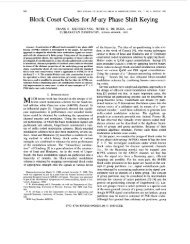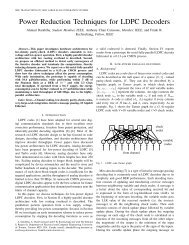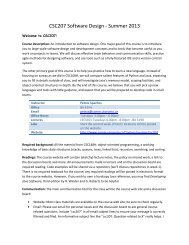Beamforming with Limited Feedback in Amplify-and-Forward ...
Beamforming with Limited Feedback in Amplify-and-Forward ...
Beamforming with Limited Feedback in Amplify-and-Forward ...
You also want an ePaper? Increase the reach of your titles
YUMPU automatically turns print PDFs into web optimized ePapers that Google loves.
3Note that, <strong>in</strong>terest<strong>in</strong>gly, this received SNR expression has thesame form as <strong>in</strong> TDMA scheduled AF systems [4, Eq.(1)].Therefore, the results <strong>in</strong> [3], [4] directly lead to the follow<strong>in</strong>gapproximations on the outage probability <strong>and</strong> probability oferror of the optimal beamform<strong>in</strong>g <strong>with</strong> unlimited feedback AFnetwork at high SNRs:whereP optout (γ t )≃P opte (γ t ) ≃(ζ 2 (m+1)R ) m+1− 1,m!(m + 1) γ t(12)ζ(2m + 1)!,m!(m + 1)!(2cγ t )m+1(13)(1m∏ 1ζ =E s σs,d2 E s σs,i2i=1)+ 1E r σi,d2(14)is a constant determ<strong>in</strong>ed by transmission power <strong>and</strong> channelvariances σs,d 2 , σ2 s,i <strong>and</strong> σ2 i,d, R is the target transmission rate<strong>and</strong> c is a constant determ<strong>in</strong>ed by the modulation scheme.The idea of an AF network <strong>with</strong> relay selection was<strong>in</strong>troduced <strong>in</strong> [3] as an improvement to the conventionalTDMA-based AF networks. The high-SNR approximation ofthe outage probability <strong>and</strong> probability of error of the selectionAF network are [3], [4](Pout(γ s ζ 2 (m+1)R ) m+1− 1t ) ≃, (15)(m + 1) γ tPe s ζ(2m + 1)!(γ t ) ≃. (16)(m + 1)!(2cγ t )m+1From (12), (13) <strong>and</strong> (15), (16) <strong>with</strong> the same transmit SNR,the performances of the two schemes satisfyP s outP optout= P esPeopt = m! (17)S<strong>in</strong>ce the high SNR approximation of the two schemesare parallel l<strong>in</strong>es <strong>with</strong> slope −(m + 1)/10 <strong>in</strong> Log-dB scale,the SNR difference for the two schemes to achieve the sameperformance is thereforeδ γ =log m!(m + 1)/10 = 10m + 1 log 10 m! (dB). (18)Therefore, the asymptotic SNR gap 1 between the selection AF10scheme <strong>and</strong> the B-UF scheme ism+1 log 10 m! dB.Apply<strong>in</strong>g √ Stirl<strong>in</strong>g’s formulalim m→∞ 2πme −m m m /m! = 1 to (18) <strong>and</strong> reta<strong>in</strong><strong>in</strong>gonly the most significant term, we can see that as the numberof relay nodes m <strong>in</strong>creases, the asymptotic SNR gap betweenselection AF <strong>and</strong> B-UF is 10 log 10 m/e dB. This gap is aquickly <strong>in</strong>creas<strong>in</strong>g function of m <strong>and</strong> may seem to be severe<strong>in</strong> large networks. For <strong>in</strong>stance, the loss is 1dB when m = 2<strong>and</strong> 1.95dB when m = 3, but it grows to 5.96dB whenm = 10. However, the optimal beamform<strong>in</strong>g scheme is highlyimpractical for any realistic application, especially when mis large, s<strong>in</strong>ce it <strong>in</strong>volves feedback of m complex numbers<strong>in</strong> real time <strong>and</strong> strict synchronization. Therefore we treatit as a performance bound only <strong>and</strong> compare more practical1 Def<strong>in</strong>ed as the difference <strong>in</strong> SNR required to achieve the same asymptoticperformance <strong>with</strong> selection AF <strong>and</strong> <strong>with</strong> B-UF.schemes us<strong>in</strong>g their performance loss to this optimal one.IV. BEAMFORMING WITH LIMITED FEEDBACKIn Section III we treated the selection AF scheme asone special case of beamform<strong>in</strong>g <strong>with</strong> limited feedback <strong>and</strong>studied its performance loss <strong>in</strong> relation to the B-UF scheme.Clearly, this loss can be reduced by <strong>in</strong>creas<strong>in</strong>g the amountof feedback. In this section, we study the performance of AFbeamform<strong>in</strong>g schemes as a function of feedback available. Insuch a network, a codebook whose size is determ<strong>in</strong>ed by theamount of feedback is first established at both the dest<strong>in</strong>ation<strong>and</strong> the relay nodes. For each transmission, the dest<strong>in</strong>ationselects the optimal codeword based on the CSI, <strong>and</strong> feedsback its <strong>in</strong>dex to the relays. The relays perform beamform<strong>in</strong>gus<strong>in</strong>g the correspond<strong>in</strong>g codeword as the weight vector.A. Optimal Codebook DesignOptimal transmit beamform<strong>in</strong>g codebook design has beenstudied <strong>in</strong> the context of s<strong>in</strong>gle-user MISO (multi-<strong>in</strong>put s<strong>in</strong>gleoutput)systems [7], [8], [12], where GLP provided the optimalcodebook design for both average received SNR [7] <strong>and</strong> outageprobability [8]. In the AF networks, however, GLP is no longeroptimal due to the noise amplification by relay nodes. TheGeneralized Lloyd Algorithm (GLA) [13] can still be used<strong>in</strong> the optimal codebook design. In particular, assum<strong>in</strong>g Bbits of feedback, the algorithm starts <strong>with</strong> a set of r<strong>and</strong>omlyselected 2 B vectors, <strong>and</strong> repeats the follow<strong>in</strong>g two steps untilconvergence:1) For each codeword <strong>in</strong> the current codebook, f<strong>in</strong>d theregion <strong>in</strong> C m for which it is the γ r -maximiz<strong>in</strong>g beamform<strong>in</strong>gvector.2) For each region, f<strong>in</strong>d a new codeword to replace thecurrent one by maximiz<strong>in</strong>g the average γ r over thatregion.Due to the complex form of γ r , only numerical resultsare available for AF relays (shown later <strong>in</strong> simulations), evenfor the special case of i.i.d channels among the network. Weare particularly <strong>in</strong>terested <strong>in</strong> log 2 m bits of feedback, for theselection scheme is a possible c<strong>and</strong>idate <strong>in</strong> this case. Unlike <strong>in</strong>MISO systems, where any orthogonal basis of m-dimensionalspace is an optimal codebook, selection (identity codebook)is the unique optimal for AF beamform<strong>in</strong>g. The reason forthe uniqueness is straightforward: although all orthogonalcodebooks achieve the same maximal received signal power,selection is the one that m<strong>in</strong>imizes noise amplification.Figure 1 shows the outage probability of these schemes <strong>in</strong>a network <strong>with</strong> 3 potential relays. All the channel ga<strong>in</strong>s <strong>in</strong>the network are i.i.d. CN (0, 1) r<strong>and</strong>om variables. From thefigures we can see the 1.95 dB performance loss betweenselection <strong>and</strong> B-UF as predicted <strong>in</strong> Table I. It also showsthat optimal beamform<strong>in</strong>g <strong>with</strong> limited feedback achieveslittle improvement over selection, while entail<strong>in</strong>g significantsystem-wide disadvantages such as extremely high complexity<strong>and</strong> slow convergence rate for GLA <strong>and</strong> synchronization ofrelays. In other words, although <strong>in</strong>creas<strong>in</strong>g the amount offeedback <strong>and</strong> design<strong>in</strong>g a near-optimal codebook throughthe GLA can improve performance, this approach <strong>in</strong>volvespractical difficulties <strong>and</strong> yields only small performance ga<strong>in</strong>s.



